Xiaohongshu Social Media Marketing Guide: How brands leverage Xiaohongshu to grow brand awareness? Part 1
January 31st, 2023
Here is how you can develop your brand awareness and start selling your products in China through Xiaohongshu (RED)
Overview of Xiaohongshu
Xiaohongshu (小紅書) also known as “little red book” or RED, is a Chinese e-commerce sharing platform for audiences in China. According to the latest sources (Graph 1: active users in 2021 in Little Red Book), RED has monthly users of 100 million active users, with 10 billion posts per day in 2020. In current years, RED has been most popular among young audiences between 18-35 years old with over 90% as female users, the rest being male. Gen Z and females are the majority users on RED.
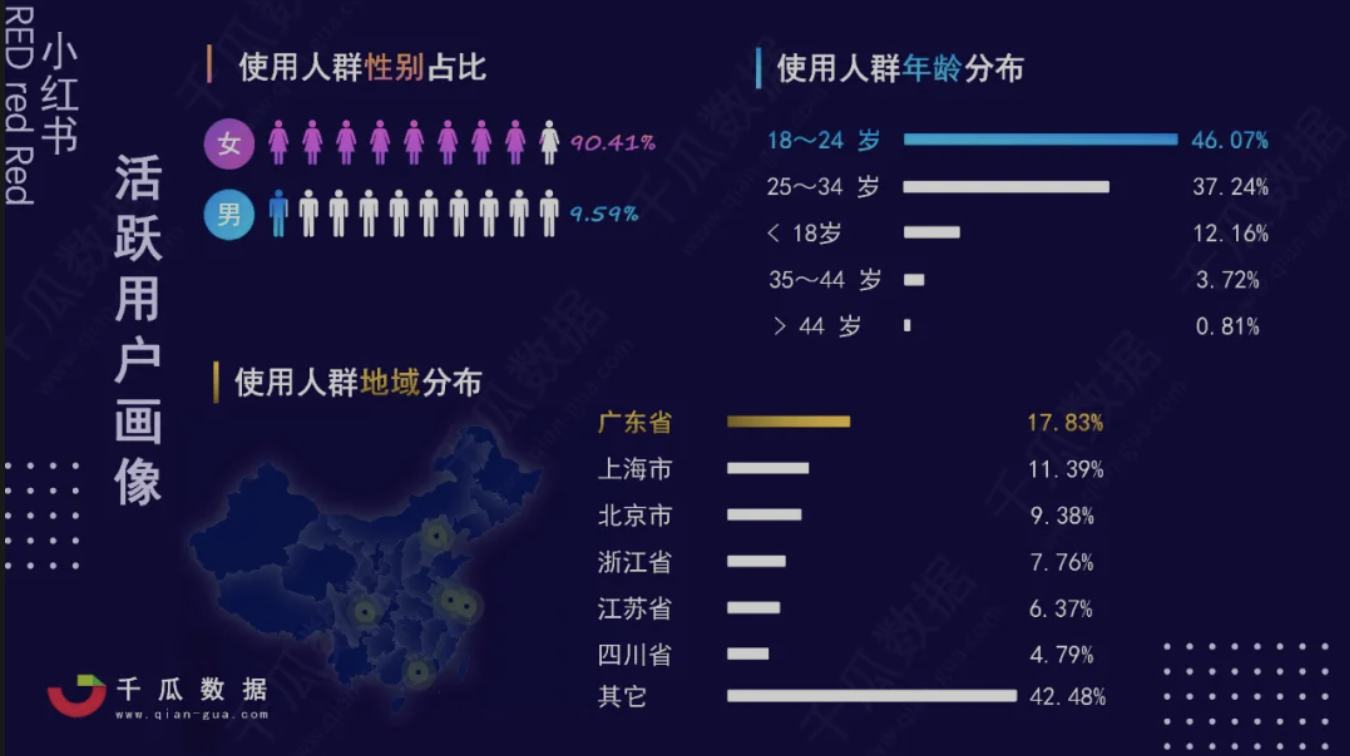 Graph 1: Active users spreadsheet of Little Red Book
Graph 1: Active users spreadsheet of Little Red Book
The most popular searches according to the data below can also show the top 3 categories in RED are makeup (in blue with 6.16%), skincare (in yellow with 6.03%) and styling (in orange with 4.66%). The discussion groups were people are most active in are also much related with the top categories, including “stylish men and women” (26.76%) , “makeup fanatics” (10.8%) and “importance of skincare routine” (9.96%). These data helps brands to understand more about what RED users are most attracted by.
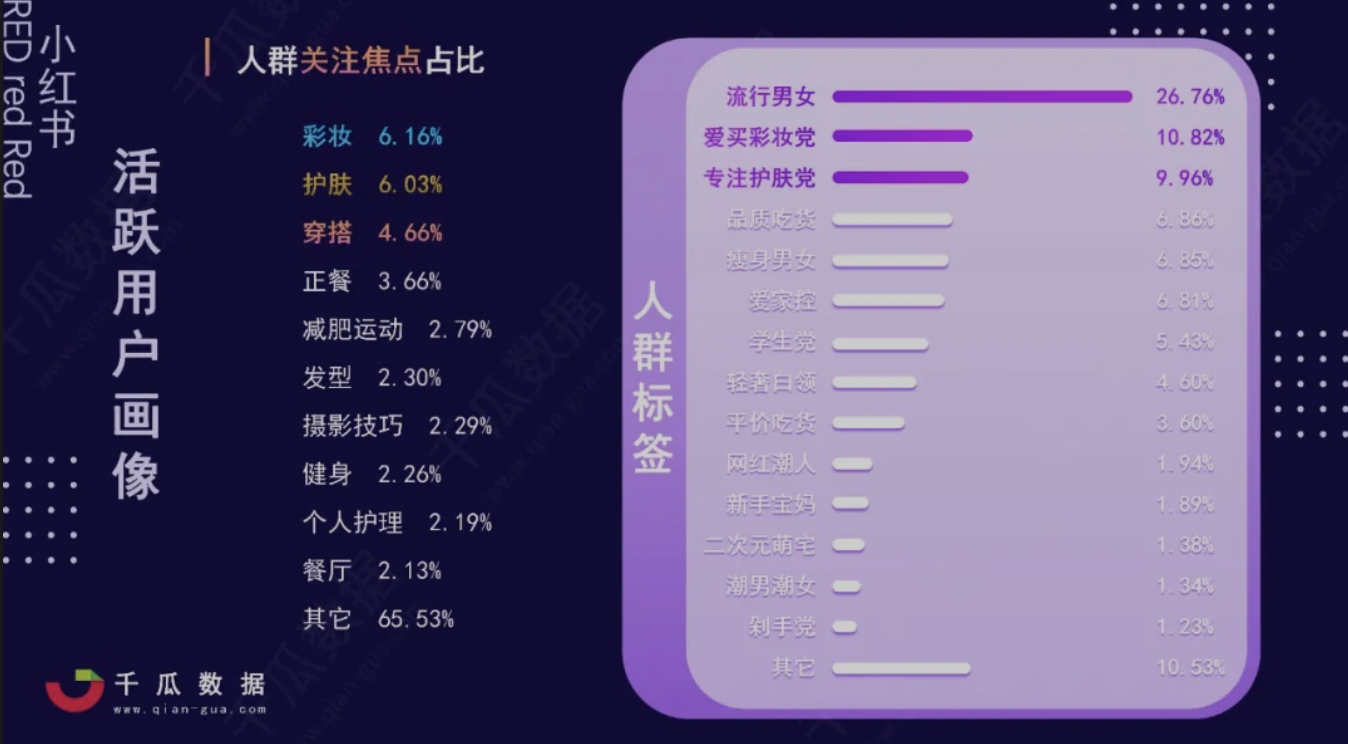 Graph 2: Most popular searches in Little Red Book
Graph 2: Most popular searches in Little Red Book
How Xiaohongshu algorithm work
To promote on RED, cooperate brands have to achieve three main goals: display your branding, set your brand reputation, and direct viewers in. Xiaohongshu’s main algorithm are the user profile, user behaviour, and content keywords. As a corporate brand, you must create attractive profiles, investigate and learn about the platform’s user behaviours, their favours in topics and find the right keywords to direct audience in.
We have mentioned the data of RED’s users in the above paragraph, in the following we give an overview of accounts that corporate brands can create on RED to complete the algorithm.
There is a 4+2 formula as to how RED’s algorithm works for brands.
First, corporate accounts. From the corporate’s point of view, brands create content about their products using professional resources like official advertisements, events, collaborations with celebrities.
Second, staff accounts. From a staff’s point of view, this can bring a brand to a more relatable view. Their contents usually are within their corporate’s framework but wording posts in a more relatable sense. Corporates can create different types of staff accounts, depending on which type of reputation they would like to set. These staff accounts could be either corporate opened or voluntarily by the staff.
Third, personal accounts. Instantly, many might think these accounts are simply influencer accounts that collaborates with corporate brands. But in fact, these personal accounts are actually born from corporate brands to create a more realistic viewpoint for their brands. These personal accounts show how the products are actually used or what they think about the products. These accounts do not have a template in their post. They simply show realistic reviews for clients.
Fourth, digital sniper accounts to help direct views into the three accounts above. These sniper accounts usually simply comments on brand accounts or different accounts to help direct audience into corporate accounts or bring out audience interest and curiosity for the brands.
Fifth, with a mix of these accounts, corporates create a marketing matrix. The recommended formula from data is to have 2-3 corporate accounts with 3-5 staff or personal accounts and 2-3 sniper accounts to direct audience into corporate accounts. However, it is up to the brand itself to arrange the amount of accounts to manage.
Lastly, create mass content with variations to attract audience. From topic, content, photos, design, layout, brands must learn to create interesting content to attract follow. But as long as you have a set structure, you can mass copy the same template with some variations. This way, the longer you manage, you have a better idea of how your brand can attract viewing on RED.
How to set-up Xiaohongshu corporate account?
With RMB600 per year, corporates can be verified on RED for one year. Foreign brands (overseas, Hong Kong and Macau registered company) must be able to provide first, an official company business registration document with verifications of the company’s stamp and the Chief Executive Operator’s signature. Second brands must have a brand name trademark document that is trademarked in China. Lastly, they have to complete an application document authorised by RED for brand official account verification.
__How to promote and market Xiaohongshu corporate account using content marketing? __
To promote and market your products of RED varies in different sectors of business. As mentioned before, a RED algorithm also includes good content, keywords that can help boost content marketing on the Chinese e-commerce. We are going to dissect different corporations for your reference to see how you could create good attractive content to direct audience into your account.
We would be case-studying from three categories: home décor, fashion and beauty.
Home Décor case study
Corporate brands for home décor must decide their brand image at an early stage. They must not be indecisive about the brand direction. Indecisiveness would affect the direction of audience into the account. Since home décor is mostly about visual and practicality, brands should also be honest and direct to the audience.
 Figure 1: 一兜糖家居- home décor brand
Figure 1: 一兜糖家居- home décor brand
Second, create story series. Like the piece in figure 2, “Measurements you must save up before renovations- Chapter 3”. This can immediately tell users that this piece has part 1,2,3 etc., such that they can head to your profile to read other series. This directs users into your account, as well as saving your post. Creating anticipation to users, telling them that there would be more than one chapter in these series. Users would be more motivated to follow you for more.
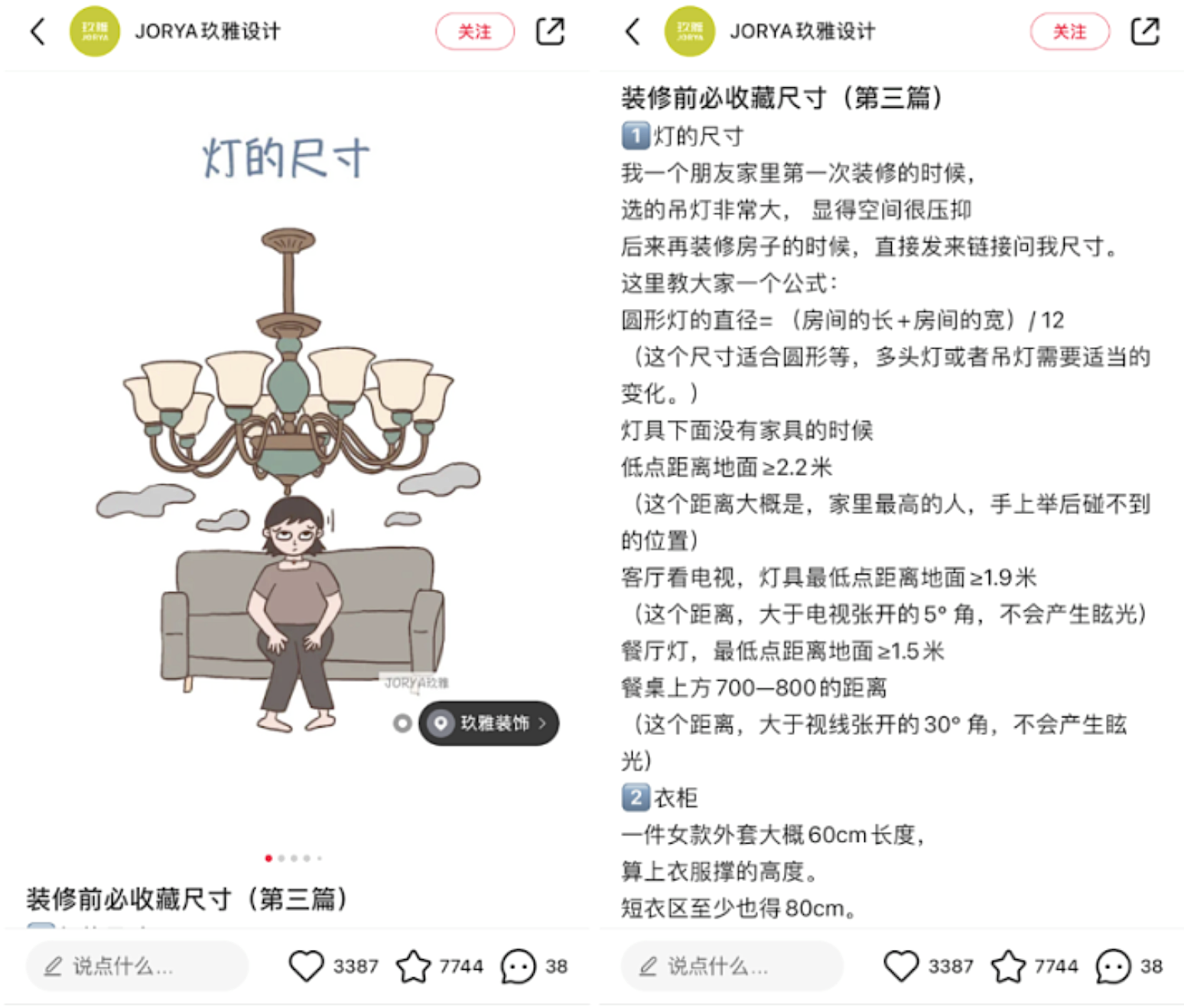 Figure 2: Jorya- interior design
Figure 2: Jorya- interior design
Third, create short videos. Creating 10-30 seconds video showcasing home décor designs can show an aesthetic feeling to our account, attracting interactions with users. Figure 3 shows “a small apartment cloakroom design in 20 seconds”. This 20 second video used 3D effects to show how a cloakroom could be designed. These quick videos actually have a lot of saves, as most people usually could not remember how it is designed within 20 seconds, thus, saving it for future references. Even after saving, they would re-watch the videos several times. Actually, packing more details and information within a short video can lead to more views, saves and even people interacting to it.
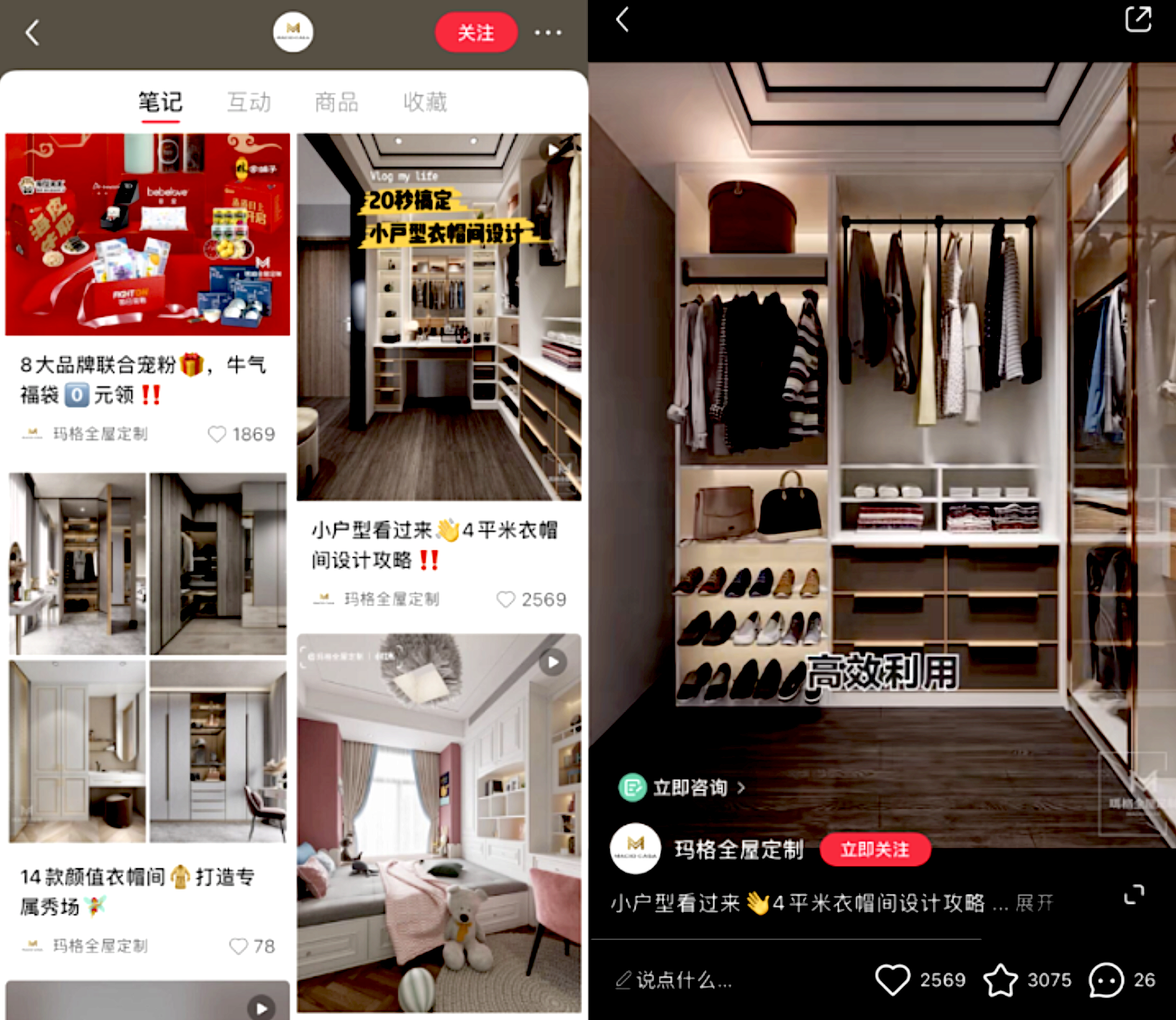 Figure 3: Macio Design – interior design
Figure 3: Macio Design – interior design
Fashion Case Study
Fashion corporate brands usually are about visuals. Either brands can go for a down-to-earth image, or aesthetic designs, or high-end modelled design.
Figure 4 shows an example of a brand that goes with a down-to-earth image. Scrolling through this type of account is like shopping live at a physical shop. This type attracts users to actually search for their physical store. This can connect with potential clients online and offline. This type of account usually has more styling tips, notes on post and easy-to-understand content. Users usually follow these accounts for their styling tips.
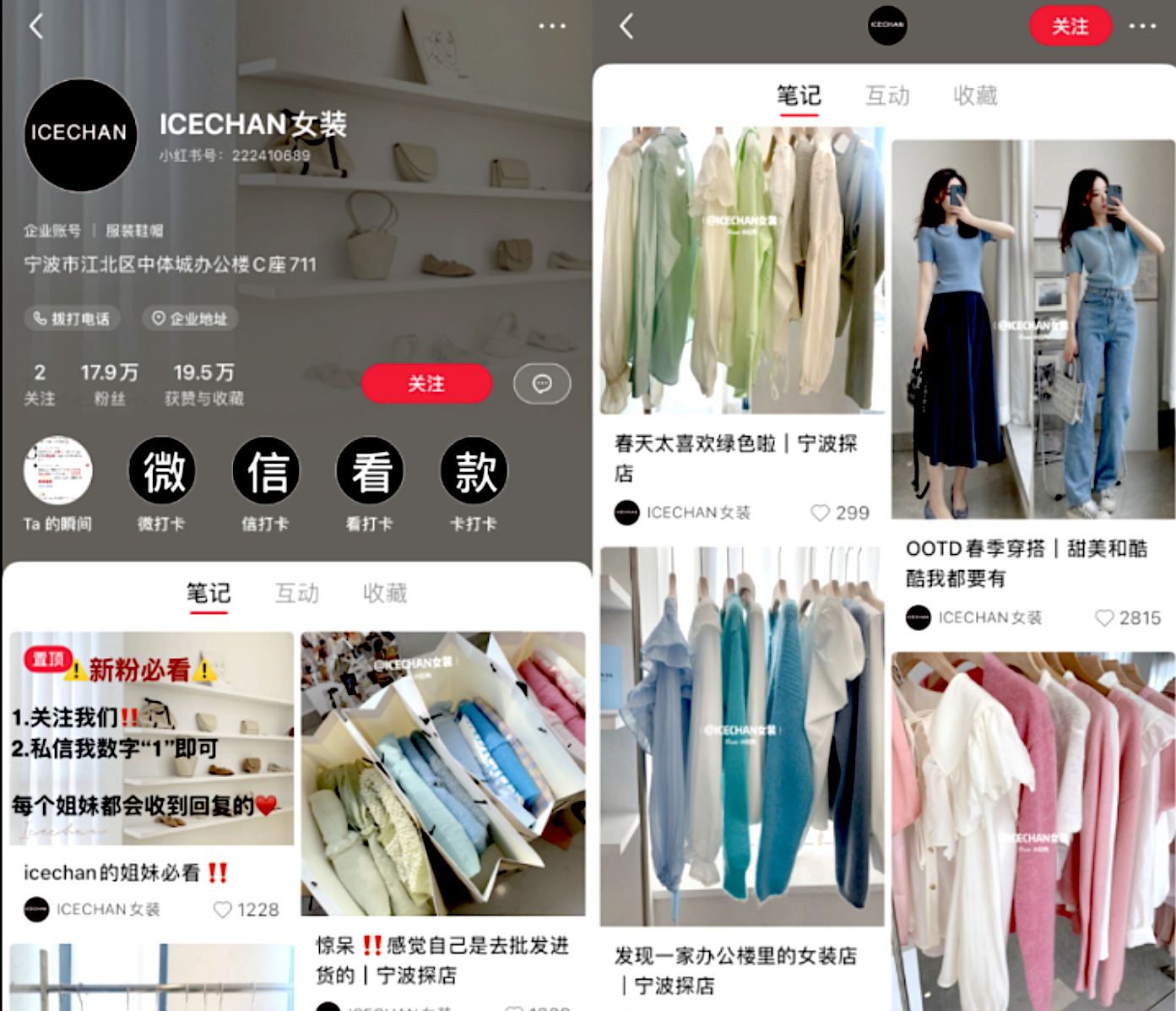 Figure 4: Icechan- fashion brand
Figure 4: Icechan- fashion brand
Another way to present your brand could be through aesthetic posts. Figure 5 shows this brand that emphasises on “outfit of the day” or “ways to style”. The styling aesthetic attracts users to click to view. The presentations are usually either a compilation of styles, or a single model shot. They arrange the page according to colours. The way the models model for the clothing are usually bright and colourful. These posts provides a soothe viewing experience. It is like entering a shop with a personal stylist providing professional tips in getting the right clothes for you. These combinations attracts a lot of audience.
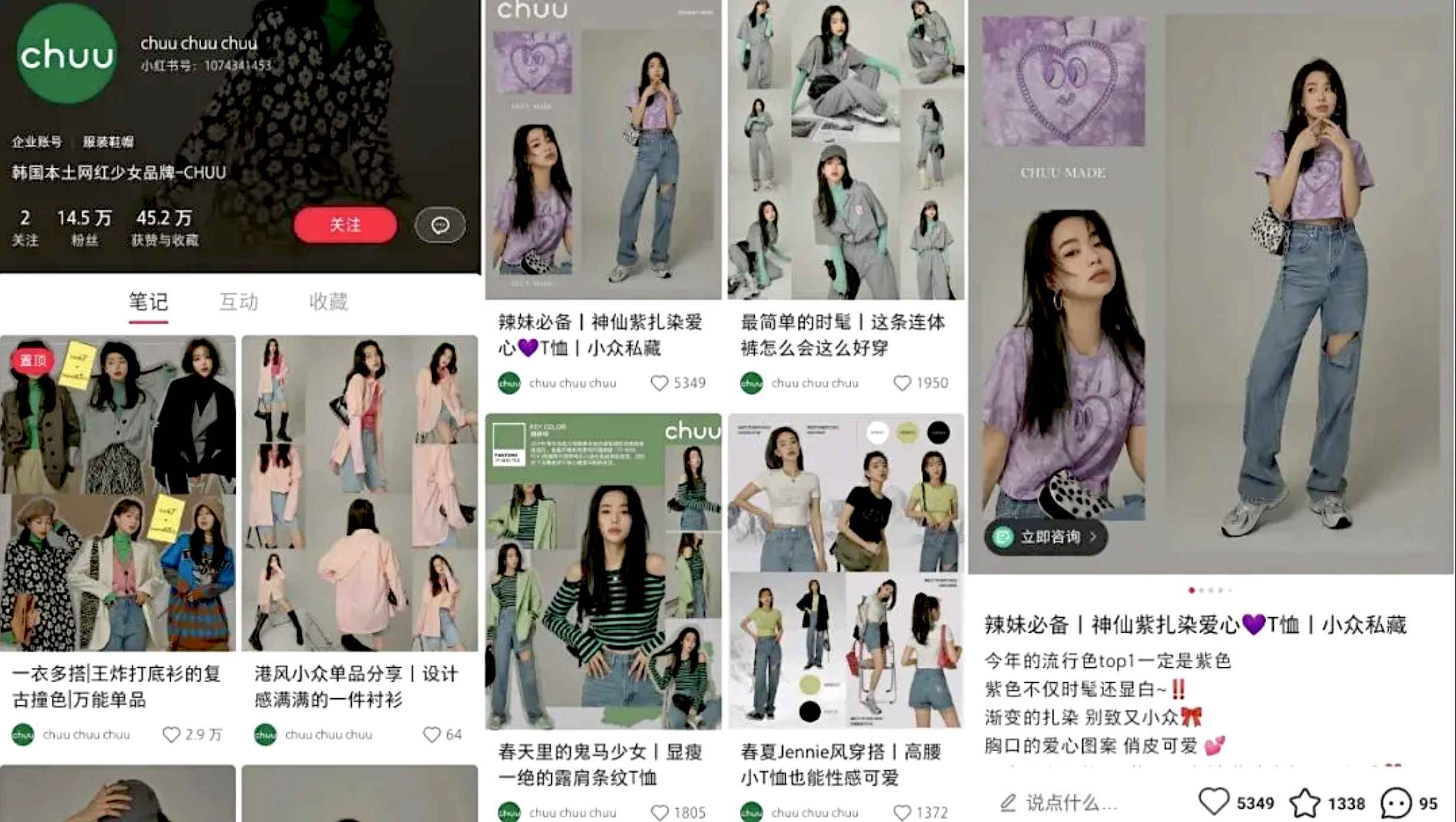 Figure 5: chuuchuuchuu – fashion brand
Figure 5: chuuchuuchuu – fashion brand
Beauty Case Study
The management for beauty corporate accounts are much similar to other beauty influencer accounts. The goal is to present how versatile and practical your brand products are. Showcasing different ways your brand products could be used can attract audience to buy the respective items, like how figure 6 and 7 presents. Not only do they present how versatile their eyeshadow palettes are, they also teach users how to create different looks with the palettes.
 Figure 6: Perfect Diary- Makeup brand
Figure 6: Perfect Diary- Makeup brand
 Figure 7: Judydoll – Makeup brand
Figure 7: Judydoll – Makeup brand
Another way to boost views is to collaborate with influencers or creators. Like this skincare brand in figure 8, collecting different reviews of influencers about their products can show users a level of insurance about the product. It could also be a win-win situation to lead users to both the corporate accounts and the influencers’ accounts.
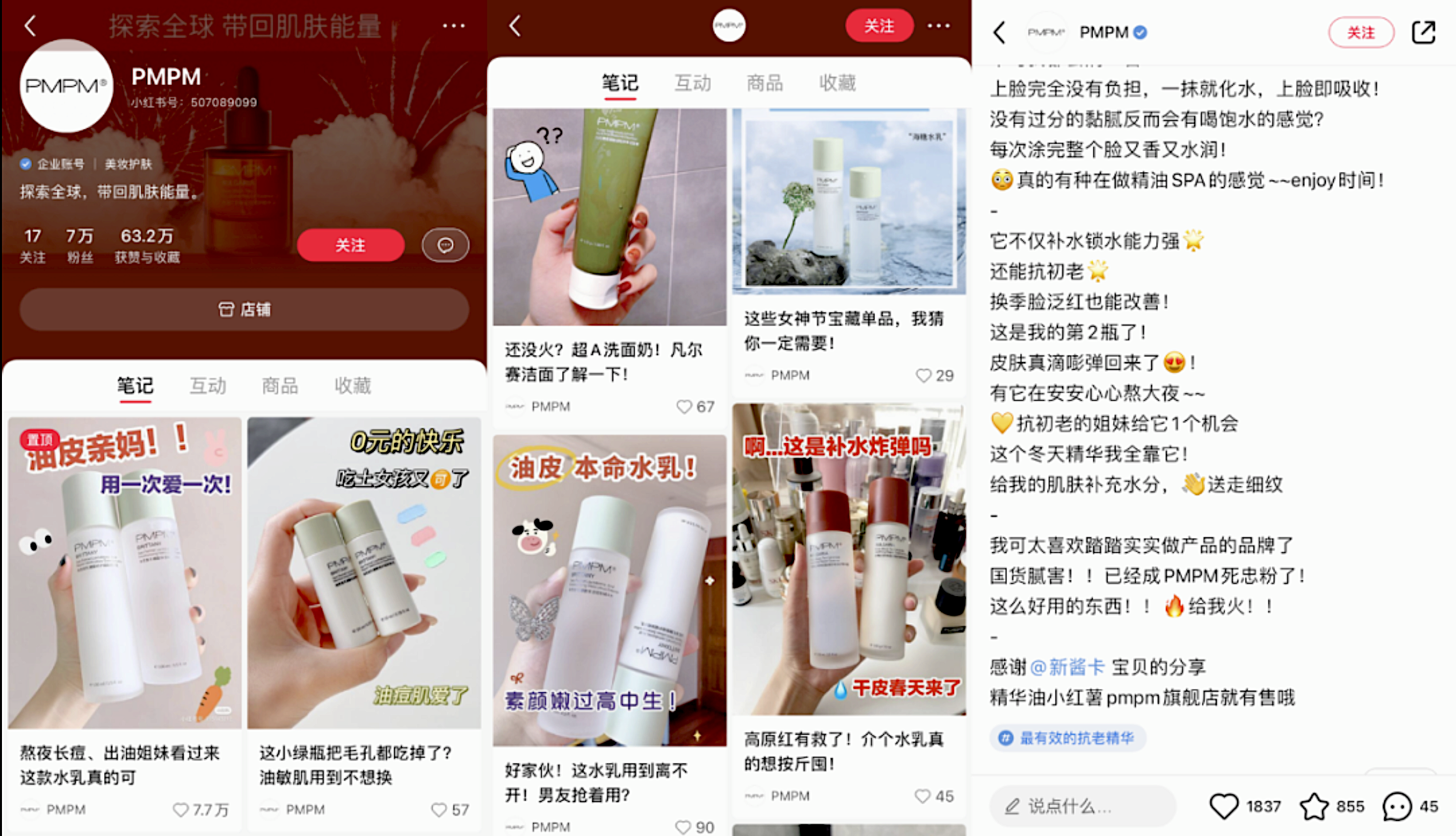 Figure 8: PMPM – Skincare brand
Figure 8: PMPM – Skincare brand
Xiaohongshu marketing tips and tricks
To better market your products and set your brand reputation, we provide the following tips to help you build your brand on RED.
First, publish in story series. Let your audience know that you have a series of inter-related content. This can allow audience to anticipate for your upcoming episodes and posts, thus willing to follow you.
Second, create tutorial content. If you are a beauty brand, do not simply promote your products. Use your products to create makeup looks so that audience could see the products in action. This way, they could understand how versatile the products are. The best way to promote is through the results the product could create, not simply how the product is by itself.
Third, collaborate with influencers/creators. If an influencer has a post with your brand’s product that has reached millions of likes, this means the post has potential of attracting audience. Contacting influencers to repost the respective post on your own corporate account can help brand exposure. It is also a win-win situation for the brand and the influencers, as brands can connect the influencers’ accounts on their products, to help influencers increase in following. The most important thing with this, is that if one post has much exposure, grasp the chance to keep the trend going and push the post to attract potential clients.
Fourth, there is a recommended corporate post proportion. Based on the above types of posts, to attract audience, series and tutorial posts should take up 50% coverage. Product presentation covers 20%, which includes showing how the product looks, how it is used, and post advertisements about the product itself. Collaboration posts with influencers covers 20%. Influencers have an important role in the social e-commerce. Having their personal review about your products can bring brands and audience to a close-knit relationship. This type of posts creates a more down to earth image for brands. The last 10% can be brand experience content, official brand promotions, advertising events, live videos etc. It is crucial that your balance out the proportions of post to create the best results.
Fifth, create collections. Collect the same or similar content to a group folder for audience to explore. Don’t forget to implement this tip for better viewing and better audience interaction.
Sixth, like most social media platforms, RED uses similar consumer psychology to attract its audience. The formula: read, like, save, comment, @, repost. However, like most posts, people lean on liking the post based on its visual attractiveness, instead of saving the post. However, in RED, comments are connected with the post. Thus, audience can directly see the comments and reactions of other users. Using this function, brands can write sentences like “tag your best friend below to try it out” or “tag your lovely partner to grab this item”. These sentences create interactions between accounts.
Seventh, remember to advertise and keep on posting. The right amount of advertisement in corporate accounts can bring audience in. Your content is key, as the system can filter how well your post connects with audience. The better your post, the higher the views and saves, RED’s system will help boost your post to support brands and accounts.
These tips can help you build your brand on RED. However, brands must also be active in producing good content and find your right keywords. Besides alerting about your topics and content, brands must learn to dissect the China social media marketing fields. The algorithm: the user profile, user behaviour, and content keywords are key things to remember for corporate brands to gain attention. If your brand is interested to sell your products through Xiaohongshu to China, to promote your brand awareness, contact us to learn how to set up your RED corporate account.